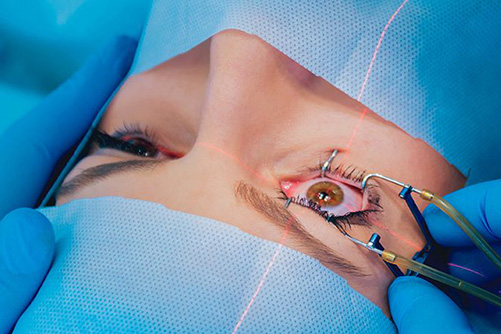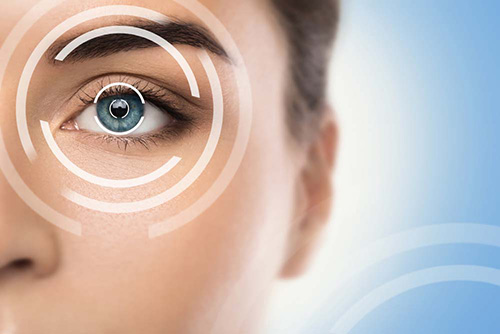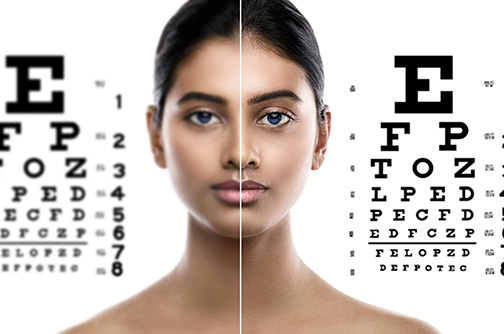Lasik Eye Surgery Procedure Details and Cost in Turkey

- What must be considered before eye correction laser surgery?
- Preliminary Examination for Laser Eye Surgery
- Lasik Eye Surgery: How is it done?
- Am I suitable for femto LASIK?
- Complications and risks of femto LASIK
- Costs of Lasik in Turkey
- Conclusion
Femto-LASIK (laser in situ keratomileusis) is the modern version of the LASIK method. In contrast to the conventional method, the laser is used in the first step (opening the cornea).
The modern Femto-LASIK method relies entirely on the use of the laser. In the classic Lasik method, a (tiny small) scalpel was used in the first treatment step.
It should be particularly emphasized that the procedure is painless for the patient, because the correction is made on layers of the cornea that are insensitive to pain.
Advantages of a Femto-LASIK treatment compared to other methods:
- Clear vision shortly after the operation
- Short healing time, little pain
- High precision thanks to modern laser technology
What must be considered before eye correction laser surgery?
If you wear contact lenses, you must stop wearing your soft contact lenses for a week before the laser eye surgery. With hard contact lenses, this period is even three weeks.Before the laser eye surgery, you will receive special eye drops from your ophthalmologist. You must drip this into your eyes regularly three days before the laser eye surgery. You can take your medication as usual and meals are also allowed on the day of the laser eye surgery. However, you should refrain from smoking and applying make-up on the day of the laser eye correction. The same applies to perfume and deodorants containing alcohol.
Don't forget to bring sunglasses with you to your laser eye surgery appointment. Your eyes are very sensitive to light after laser eye surgery. After the laser eye surgery, you only have to stay in the clinic for about 20 to 30 minutes. Your eyesight should have stabilized as much as possible just one day after the laser eye operation. How long the actual healing takes varies from patient to patient. Expect about four to six weeks after the laser eye surgery until your vision has completely stabilized.
Preliminary Examination for Laser Eye Surgery

During the preliminary examination for an eye laser treatment, the patient is checked for basic suitability. Aspects such as the severity of the ametropia, stability of the glasses values or allergies are in the foreground.
Before any laser eye treatment, it is imperative to carry out certain preliminary examinations in order to select the persons who can be treated. There are exclusion criteria that can only be clarified with highly specialized examination techniques. This is of such great importance because the risk of complications is drastically increased in certain individuals. These preliminary examinations separate the high-risk from the low-risk eye laser treatments - to ensure maximum safety. This article gives you, as an interested person, an insight into the sub-areas of the preliminary investigations.
General aspects in the preliminary study
As with any medical examination, we start with a conversation to get an impression of the patient's wishes and ideas. This is necessary to find out whether the patient's expectations are realistic and whether they can be met with laser eye treatment. Then general diseases are discussed, as there are some that make laser eye treatment impossible. Another point is that of allergies - if patients are allergic to drugs used during the operation, this can lead to serious complications.
Specific eye exams
Of course, it is important to find out whether the eye is suitable for such an operation or not. Each preliminary examination includes a short eye test with and without glasses/contact lenses. Not all laser eye treatments can be applied to all ametropia - it is therefore necessary to determine what type and, above all, to what extent the ametropia is present. In addition, it is asked whether the glasses values have changed in recent years. Laser eye treatments can only be carried out if these values have remained reasonably stable recently. However, you have to resort to highly specialized examination techniques for the eye fairly quickly, as this is the only way to make a conclusive assessment as to whether treatment is an option. The focus here is on the so-called “anterior segment of the eye”, since eye laser treatments are usually limited to this region. Below is a selection (not exhaustive) of common examination techniques.
Slit lamp biomicroscopy

This examination is the best way to examine the anterior segment of the eye. First, the eyelids are checked for inflammatory changes that could interfere with the laser eye treatment. The conjunctiva is then inspected - an important examination step, as superficial irritation can develop here after years of wearing contact lenses, which must be ruled out. The next target is the cornea, which is the actual target organ of the laser eye treatment. Slit lamp biomicroscopy can be used to find out whether the cornea is intact. Irritations, blood vessels and scars should be looked for, as these all make laser eye treatment difficult.
Korneale Pachymetrie
This examination provides another crucial value that must be recorded during laser eye treatments: the thickness of the cornea. Certain methods can only be used from a certain thickness, which is why the thickness must be recorded in advance.
Examination of the corneal topography
With this examination, the surface profile of the cornea can be displayed. This is crucial because it allows you to recognize changes in shape that make laser eye treatment impossible. Irregular bumps, for example, are difficult for the laser to detect during the operation, which could lead to serious complications.
Others
As mentioned above, this list is not complete. It always depends on the tests that have already been carried out as to what needs to be clarified in a further step. In conclusion, one can say that in such a preliminary examination, all examinations are carried out in order to be able to say with certainty that an eye is healthy. This means maximum safety for the patient during an eye laser treatment.
Lasik Eye Surgery: How is it done?
First, a so-called flap is created with the help of the femtosecond laser by opening the top layer of the cornea. A second laser, the excimer laser, is then used to perform the actual correction on a deeper layer of the cornea. The laser removes as much corneal tissue as is necessary so that sharp vision is possible again. Finally, the flap is put back in its original position. There it acts like a natural plaster, which is placed on the processed corneal layer. To protect the cornea, a special contact lens (bandage lens) is used for a short time after the operation, which is intended to protect the eye from dirt and drying out.

Am I suitable for femto LASIK?
The requirements for performing femto-LASIK are the same as for LASIK itself. The following ametropia can be treated:
- Short-sightedness (myopia) up to -10.0dpt
- Long-sightedness (hyperopia) up to +3.0dpt
- Corneal curvature (astigmatism) up to 6.0dpt
General inclusion criteria are:
- Age over 20 years
- Stable refraction (no change in lens power) for 1-2 years
- No lactation/pregnancy
- No tear secretion disorder
- Minimum thickness of the cornea
Eye diseases that need to be ruled out:
- Cataracts
- Glaucoma (Glaucoma)
- Retinal diseases
Some diseases preclude such treatment. Common examples are:
- Keratoconus (corneal deformity)
- Corneal degeneration
- Diabetes mellitus
- Inflammatory eye diseases
Complications and risks of femto LASIK
As modern and sophisticated as modern laser eye correction is, about a third of all patients suffer from side effects after laser eye surgery. Burning and itching after the procedure is not uncommon and affects many patients. It can also be that you can see worse in the twilight than before. Driving in the dark in particular can then become a problem for many patients.Eye correction laser surgery is now a standard procedure that entails hardly any risks. However, it is quite possible that the laser eye surgery does not lead to the desired success and the patient is still dependent on glasses or contact lenses.
So opt for a renowned clinic with experienced specialists who only use high-quality special equipment for laser eye surgery. Such clinics usually use excimer laser surgery for eye correction, which works with an accuracy of 1/1000 millimeter. The femtosecond laser is used less frequently in laser eye surgery.
The Femto LASIK method is performed using the latest technology, which means that serious complications have become a rarity. In addition, only the first step (femtolaser) is new - the actual correction is carried out using the tried and tested LASIK method. Nevertheless, no intervention is without complications. Below is a list of possible complications:
- Dry eyes (common, harmless)
- Temporary retention of cellular material and blisters after laser application (common, harmless)
- Over/under correction (rare)
- Incorrect flap architecture (rare)
- Imaging/visual disturbances (rare)
Costs of Lasik in Turkey
A laser treatment using the Femto-LASIK method costs 1800 euro per eye in European countries. In Turkey lasik eye surgery prices are %70 cheaper compared to Europe.

Conclusion
Femto LASIK is a state-of-the-art, safe method for correcting ametropia. Satisfactory results are achieved for the vast majority of patients and surgery enables everyday life without glasses. If you have any questions or want to make an appointment, do not hesitate to contact us.There are no comments yet. Would you like to add a comment?
In accordance with Article 10 of the Personal Data Protection Law (PDPL,KVKK) titled Data Controller's Obligation to Disclose, we use cookies in accordance with the legislation, limited to the purposes specified in the privacy policy.

